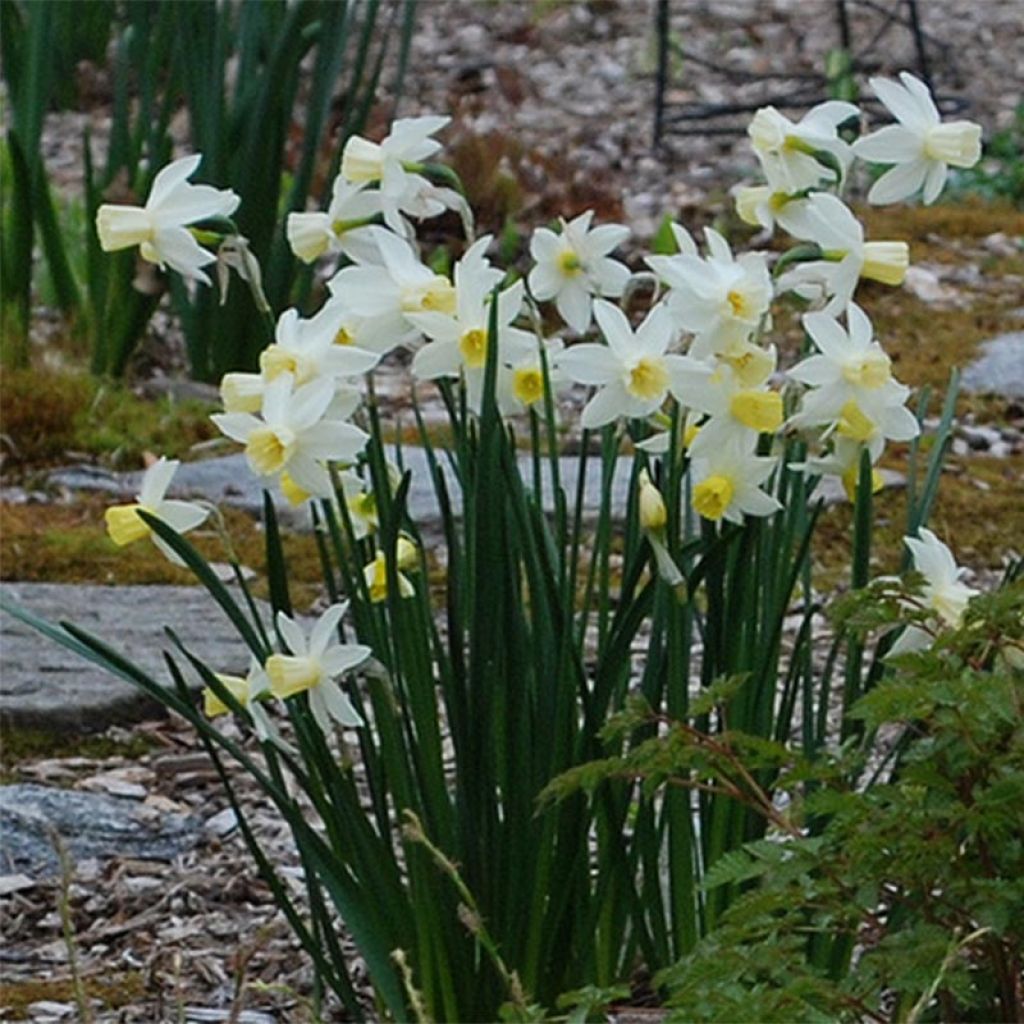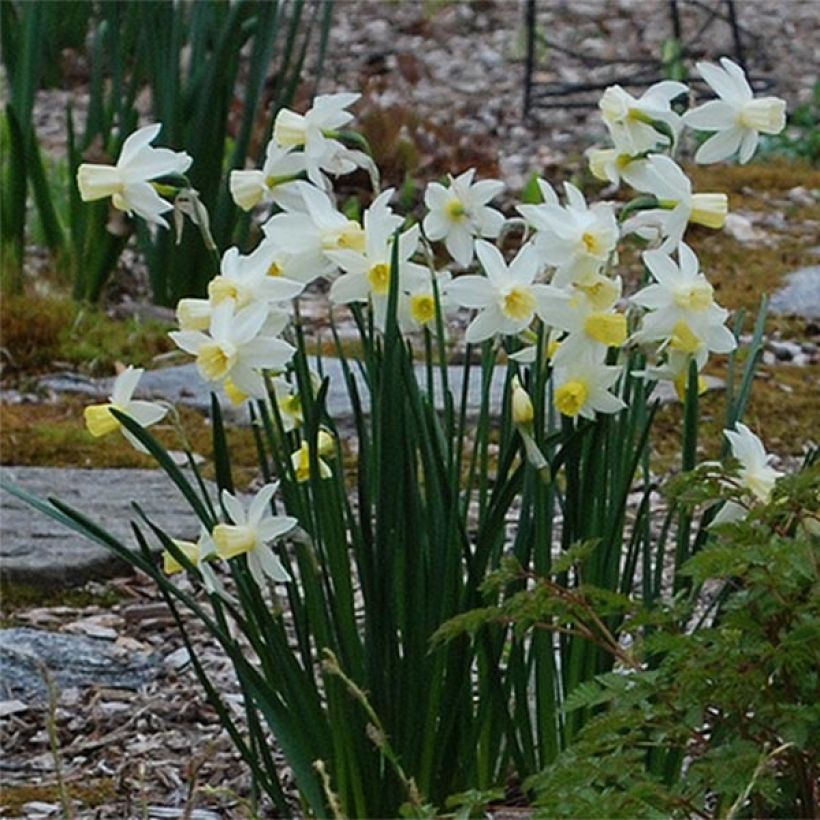

Narcisse Bella Estrella
Narcissus Bella Estrella
Narcissus Bella Estrella
Daffodil 'Bella Estrella'
Lightness, grace,
paul, 04/11/2022
This plant carries a 6 months recovery warranty
More information
We guarantee the quality of our plants for a full growing cycle, and will replace at our expense any plant that fails to recover under normal climatic and planting conditions.
From €5.90 for pickup delivery and €6.90 for home delivery
Express home delivery from €8.90.

Does this plant fit my garden?
Set up your Plantfit profile →
Description
Narcissus 'Bella Estrella' blooms in abundance for a long time. Its deliciously fragrant unique flowers are as light and vibrant as butterflies. They are adorned with a split and undulating pale-yellow trumpet, nestled in a corolla of large white petals. This variety performs particularly well in hot climates, in well-drained, fertile, and loosened soil. It is a remarkable bouquet flower, and also creates a beautiful effect in borders, flower beds, or large pots. This hardy plant is easy to grow.
Narcissus 'Bella Estrella' belongs to the Amaryllidaceae family. The Narcissus genus includes about 50 species found mainly in the Western Mediterranean, but also in Africa and Asia. Narcissus 'Bella Estrella' stands out with its light and vibrant flowering and its delightful fragrance. Its foliage reaches about 30cm (12in) in height. When in bloom, it reaches 40cm (16in). Its swirling flowers are a combination of pale-yellow and white. This variety blooms in April, for at least three weeks. The linear foliage is deciduous and disappears in summer. This variety easily multiplies by producing bulblets.
Narcissus 'Bella Estrella' is not demanding and grows well in any well-drained and loosened soil, but the results are less favourable in excessively wet or excessively acidic soils.
There are so many daffodil cultivars that one can enjoy them for three months in spring without ever getting tired. They all have in common the ability to naturalise easily, to offer an infinite range of yellow and white shades, and to often emit sweet fragrances. Grow them in large clumps in lawns or at the edge of flower beds (at least 20 bulbs) for an enhanced effect. Pair 'Bella Estrella' with squills, hyacinths, double tulips, forget-me-nots, pansies, or liverworts. A group of 'Bella Estrella' daffodils in a vase creates a sensational effect. This daffodil is also perfect in pots.
For bouquets, we advise against mixing narcissus with other flowers, especially tulips, as daffodil stems contain a substance that causes other flowers to wilt quickly. This detrimental effect on other flower species can be attenuated by dipping the ends of narcissus stems in hot water for 1 to 2 minutes.
Report an error about the product description
Narcissus Bella Estrella in pictures


Plant habit
Flowering
Foliage
Botanical data
Narcissus
Bella Estrella
Amaryllidaceae
Daffodil 'Bella Estrella'
Cultivar or hybrid
Planting and care
It grows in any well-drained and loosened soil, but the results are less favourable in soils that are too wet in summer or excessively acidic. Plant the bulbs from September to mid-December, at a depth of 15cm (6in), with a spacing of 10cm (4in), in a sunny or semi-shaded location (at least 4 hours of sun per day). Do not disturb them and, every year, your daffodils will produce more and more flowers. Remove the faded flowers to prevent the bulb weakening from seed production. You can cut the foliage once it has withered and turned yellow.
The bulbs won't flower as well if the clumps become too dense. They can be divided from July to September when the leaves are dry. You can immediately replant the (undamaged) bulbs.
Planting period
Intended location
Care
-
, onOrder confirmed
Reply from on Promesse de fleurs
Haven't found what you were looking for?
Hardiness is the lowest winter temperature a plant can endure without suffering serious damage or even dying. However, hardiness is affected by location (a sheltered area, such as a patio), protection (winter cover) and soil type (hardiness is improved by well-drained soil).

Photo Sharing Terms & Conditions
In order to encourage gardeners to interact and share their experiences, Promesse de fleurs offers various media enabling content to be uploaded onto its Site - in particular via the ‘Photo sharing’ module.
The User agrees to refrain from:
- Posting any content that is illegal, prejudicial, insulting, racist, inciteful to hatred, revisionist, contrary to public decency, that infringes on privacy or on the privacy rights of third parties, in particular the publicity rights of persons and goods, intellectual property rights, or the right to privacy.
- Submitting content on behalf of a third party;
- Impersonate the identity of a third party and/or publish any personal information about a third party;
In general, the User undertakes to refrain from any unethical behaviour.
All Content (in particular text, comments, files, images, photos, videos, creative works, etc.), which may be subject to property or intellectual property rights, image or other private rights, shall remain the property of the User, subject to the limited rights granted by the terms of the licence granted by Promesse de fleurs as stated below. Users are at liberty to publish or not to publish such Content on the Site, notably via the ‘Photo Sharing’ facility, and accept that this Content shall be made public and freely accessible, notably on the Internet.
Users further acknowledge, undertake to have ,and guarantee that they hold all necessary rights and permissions to publish such material on the Site, in particular with regard to the legislation in force pertaining to any privacy, property, intellectual property, image, or contractual rights, or rights of any other nature. By publishing such Content on the Site, Users acknowledge accepting full liability as publishers of the Content within the meaning of the law, and grant Promesse de fleurs, free of charge, an inclusive, worldwide licence for the said Content for the entire duration of its publication, including all reproduction, representation, up/downloading, displaying, performing, transmission, and storage rights.
Users also grant permission for their name to be linked to the Content and accept that this link may not always be made available.
By engaging in posting material, Users consent to their Content becoming automatically accessible on the Internet, in particular on other sites and/or blogs and/or web pages of the Promesse de fleurs site, including in particular social pages and the Promesse de fleurs catalogue.
Users may secure the removal of entrusted content free of charge by issuing a simple request via our contact form.
The flowering period indicated on our website applies to countries and regions located in USDA zone 8 (France, the United Kingdom, Ireland, the Netherlands, etc.)
It will vary according to where you live:
- In zones 9 to 10 (Italy, Spain, Greece, etc.), flowering will occur about 2 to 4 weeks earlier.
- In zones 6 to 7 (Germany, Poland, Slovenia, and lower mountainous regions), flowering will be delayed by 2 to 3 weeks.
- In zone 5 (Central Europe, Scandinavia), blooming will be delayed by 3 to 5 weeks.
In temperate climates, pruning of spring-flowering shrubs (forsythia, spireas, etc.) should be done just after flowering.
Pruning of summer-flowering shrubs (Indian Lilac, Perovskia, etc.) can be done in winter or spring.
In cold regions as well as with frost-sensitive plants, avoid pruning too early when severe frosts may still occur.
The planting period indicated on our website applies to countries and regions located in USDA zone 8 (France, United Kingdom, Ireland, Netherlands).
It will vary according to where you live:
- In Mediterranean zones (Marseille, Madrid, Milan, etc.), autumn and winter are the best planting periods.
- In continental zones (Strasbourg, Munich, Vienna, etc.), delay planting by 2 to 3 weeks in spring and bring it forward by 2 to 4 weeks in autumn.
- In mountainous regions (the Alps, Pyrenees, Carpathians, etc.), it is best to plant in late spring (May-June) or late summer (August-September).
The harvesting period indicated on our website applies to countries and regions in USDA zone 8 (France, England, Ireland, the Netherlands).
In colder areas (Scandinavia, Poland, Austria...) fruit and vegetable harvests are likely to be delayed by 3-4 weeks.
In warmer areas (Italy, Spain, Greece, etc.), harvesting will probably take place earlier, depending on weather conditions.
The sowing periods indicated on our website apply to countries and regions within USDA Zone 8 (France, UK, Ireland, Netherlands).
In colder areas (Scandinavia, Poland, Austria...), delay any outdoor sowing by 3-4 weeks, or sow under glass.
In warmer climes (Italy, Spain, Greece, etc.), bring outdoor sowing forward by a few weeks.


































